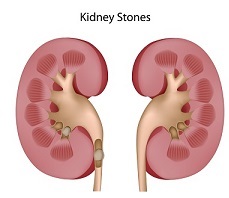Kidney Stones
Kidney Stones (renal calculi) are formed as a result of a buildup of dissolved minerals on the inner lining of the kidneys. Once they make their way into the urinary tract severe pain in the groin, stomach, or flank area can ensue. A decrease in urination coupled with a large amount of stone-forming substances can cause these types of stones to appear. These stones can be formed by the mixture of calcium with oxalate or phosphate; and/or the combination of uric acid and amino acid cysteine.
Much like Gout, Kidney stones are being diagnosed more and more in recent years. The same type of stones can develop in the bladder as well, but are much more uncommon and have remained relatively low and unchanged by comparison. Over the span of almost 30 years, the Mayo Clinic observed a significant rise in the incidences of kidney stones; particularly in adult women. With more accurate CT scans our ability to monitor and diagnose stones are partly behind a good portion of this rise in cases, but also goes hand in hand with the rise in Obesity and Diabetes Type 2. Diets high in sugar, unhealthy fats, and salt have been to blame for stones and this type of diet certainly fits the profile for all of these conditions.
Passing a Kidney Stone
This is quite possibly one of the most painful things someone could experience, aside of childbirth. Some can even grow to the size of a large golf ball full of sharp crystal formations. This can cause blood in the urine, pus, reduced urine excretion, burning, constant urge to urinate, fever, chills, vomiting and nausea — all on top of the severe pain in the groin or on the side. Blockages are always a risk, as well as a higher risk of developing chronic kidney disease.

The development of Gout and Kidney stones can stem from the same causes such as:
- Dehydration
- Excessive Alcohol Use
- Renal Failure
- Excessive Uric Acid Production
- A diet high in sugar, bad fats, and the wrong/too much salt
Other tips include:
Be sure to replace any water lost through sweating, in addition to drinking enough in the first place. There are many oxalate-rich foods we shouldn’t be avoiding. In theory, it may make since to reduce the very thing that these stones can be made of. However, if you try to eat calcium and oxalate rich foods together where they are able to bind together in the stomach and intestines before the kidneys can process it, you can likely reduce the stones from forming. Same goes for people being told to reduce their calcium intake.
Calcium is not the enemy and a diet low in calcium can actually increase your chances of developing kidney stones. Your calcium sources should mainly come from the right food choices, not just a supplement. Passing one stone doesn’t mean your done. Be sure to take preventative measures not only to avoid this excruciating passing, but to protect your kidneys in general. Lemon and limes are good for you, NOT sugar-laden, commercial lemonade. The citrates in these fruits can offer you stone prevention, but be sure to leave out the stone causing sugar. You can make your own with some fresh squeezed lemon, pure water, and an all natural sweetener like Stevia. Aim for a pH balanced diet.
If you begin experiencing any pain in the lower back, blood in the urine, cramping, chills, and/or nausea/vomiting you should seek help. Kidney stones can be very serious and very painful.
Gout can begin as symptoms of pain in the joints (big toe, feet, hands, ankles, hands, knees) and quickly escalate to a full blown attack.
Great, I really like it! Youre awesome
I am pleased that I noticed this blog, just the right info that I was looking for! .